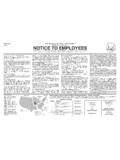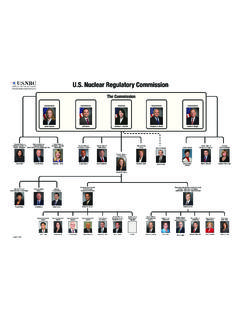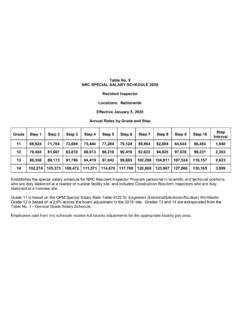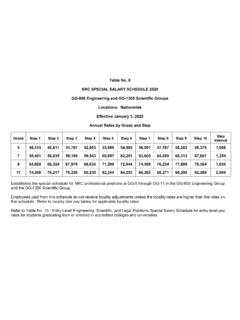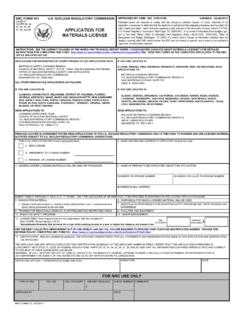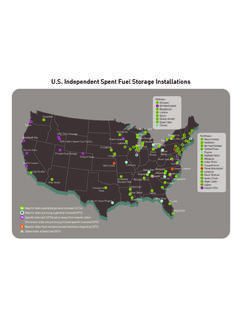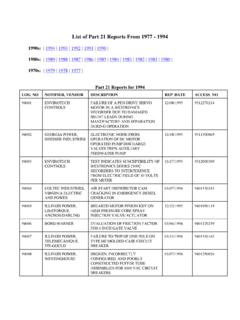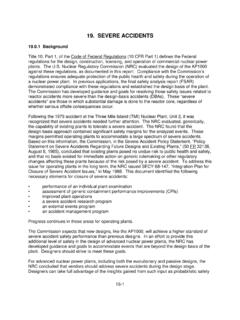Transcription of Piping Inspection Code - Nuclear Regulatory Commission
1 ENT000447. Submitted: March 30, 2012. Piping Inspection code Inspection , Repair, Alteration, and Rerating of In-Service Piping Systems API 570. Second Edition, October 1998. -1- Piping Inspection code Inspection , Repair, Alteration, and Rerating of In-Service Piping Systems Downstream Segment API 570. Second Edition, October 1998. -2- FOREWORD. It is the intent of API to keep this publication up to date. All Piping system owners and operators are invited to report their experiences in the Inspection and repair of Piping systems whenever such experiences may suggest a need for revising or expanding the practices set forth in API 570. This edition of API 570 supersedes all previous editions of API 570, Piping Inspection code : Inspection , Repair, Alteration, and Rerating of In-Service Piping Systems. Each edition, revision, or addenda to this API standard may be used beginning with the date of issuance shown on the cover page for that edition, revision, or addenda.
2 Each edition, revision, or addenda, to this API standard becomes effective six months after the date of issuance for equipment that is rerated, reconstructed, relocated, repaired, modified (altered), inspected, and tested per this standard. During the six-month time between the date of issuance of the edition, revision, or addenda and the effective date, the user shall specify to which edition, revision, or addenda, the equipment is to be, rerated, reconstructed, relocated, repaired, modified (altered), inspected and tested. API publications may be used by anyone desiring to do so. Every effort has been made by the Institute to assure the accuracy and reliability of the data contained in them; however, the Institute makes no representation, warranty, or guarantee in connection with this publication and hereby expressly disclaims any liability or responsibility for loss or damage resulting from its use or for the violation of any federal, state, or municipal regulation with which this publication may conflict.
3 Suggested revisions are invited and should be submitted to the director of the Downstream Segment, American Petroleum Institute, 1220 L Street, , Washington, 20005. 1 Scope General Application Coverage API 570 covers Inspection , repair, alteration, and rerating procedures for metallic Piping systems that have been in-service. Intent API 570 was developed for the petroleum refining and chemical process industries but may be used, where practical, for any Piping system. It is intended for use by organizations that maintain or have access to an authorized Inspection agency, a repair organization, and technically qualified Piping engineers, inspectors, and examiners, all as defined in Section 3. Limitations API 570 shall not be used as a substitute for the original construction requirements governing a Piping system before it is placed in-service; nor shall it be used in conflict with any prevailing Regulatory requirements. Specific Applications Included Fluid Services Except as provided in , API 570 applies to Piping systems for process fluids, hydrocarbons, and similar flammable or toxic fluid services, such as the following: a.
4 Raw, intermediate, and finished petroleum products. b. Raw, intermediate, and finished chemical products. c. Catalyst lines. d. Hydrogen, natural gas, fuel gas, and flare systems. -3- e. Sour water and hazardous waste streams above threshold limits, as defined by jurisdictional regulations. f. Hazardous chemicals above threshold limits, as defined by jurisdictional regulations. Excluded and Optional Piping Systems The fluid services and classes of Piping systems listed below are excluded from the specific requirements of API 570. but may be included at the owner's or user's (owner/user's) option. a. Fluid services that are excluded or optional include the following: 1. Hazardous fluid services below threshold limits, as defined by jurisdictional regulations. 2. Water (including fire protection systems), steam, steam-condensate, boiler feed water, and Category D fluid services, as defined in ASME b. Classes of Piping systems that are excluded or optional are as follows: 1.
5 Piping systems on movable structures covered by jurisdictional regulations, including Piping systems on trucks, ships, barges, and other mobile equipment. 2. Piping systems that are an integral part or component of rotating or reciprocating mechanical devices, such as pumps, compressors, turbines, generators, engines, and hydraulic or pneumatic cylinders where the primary design considerations and/or stresses are derived from the functional requirements of the device. 3. Internal Piping or tubing of fired heaters and boilers, including tubes, tube headers, return bends, external crossovers, and manifolds. 4. Pressure vessels, heaters, furnaces, heat exchangers, and other fluid handling or processing equipment, including internal Piping and connections for external Piping . 5. Plumbing, sanitary sewers, process waste sewers, and storm sewers. 6. Piping or tubing with an outside diameter not exceeding that of NPS . 7. Nonmetallic Piping and polymeric or glass-lined Piping .
6 2 References The most recent editions of the following standards, codes, and specifications are cited in this code . API. 510 Pressure Vessel Inspection code Publ 920 Prevention of Brittle Fracture of Pressure Vessels Publ 2201 Procedures for Welding or Hot Tapping on Equipment Containing Flammables RP 574 Inspection of Piping System Components RP 651 Cathodic Protection of Aboveground Petroleum Storage Tanks RP 750 Management of Process Hazards Std 598 Valve Inspection and Testing Guide for Inspection of Refinery Equipment, Chapter II (This document will be replaced by API RP 571, Conditions Causing Deterioration or Failures, currently under development.). API 570 Inspector Certification Exam Body of Knowledge ASME. Valves-Flanged, Threaded, and Welding End Process Piping B31G Manual for Determining the Remaining Strength of Corroded Pipelines Boiler and Pressure Vessel code , Section VIII, Divisions 1 and 2; Section IX, ASNT. SNT-TC-1A. CP-189 Standard for Qualification and Certification of Nondestructive Testing Personnel -4- ASTM.
7 G57 Method for Field Measurement of Soil Resistivity Using the Wenner Four-Electrode Method NACE. RP0169 Control of External Corrosion on Underground or Submerged Metallic Piping Systems RP0170 Protection of Austenitic Stainless Steels from Polythionic Acid Stress Corrosion Cracking During Shutdown of Refinery Equipment RP0274 High-Voltage Electrical Inspection of Pipeline Coatings Prior to Installation RP0275 Application of Organic Coatings to the External Surface of Steel Pipe for Underground Service NFPA. 704 Identification of the Fire Hazards of Materials 3 Definitions For the purposes of this standard, the following definitions apply. alteration: A physical change in any component that has design implications affecting the pressure containing capability or flexibility of a Piping system beyond the scope of its design. The following are not considered alterations: comparable or duplicate replacement; the addition of any reinforced branch connection equal to or less than the size of existing reinforced branch connections; and the addition of branch connections not requiring reinforcement.
8 Applicable code : The code , code section, or other recognized and generally accepted engineering standard or practice to which the Piping system was built or which is deemed by the owner or user or the Piping engineer to be most appropriate for the situation, including but not limited to the latest edition of ASME ASME : A shortened form of ASME , Process Piping , published by the American Society of Mechanical Engineers. ASME is written for design and construction of Piping systems. However, most of the technical requirements on design, welding, examination, and materials also can be applied in the Inspection , rerating, repair, and alteration of operating Piping systems. When ASME cannot be followed because of its new construction coverage (such as revised or new material specifications, Inspection requirements, certain heat treatments, and pressure tests), the Piping engineer or inspector shall be guided by API 570 in lieu of strict conformity to ASME As an example of intent, the phrase principles of ASME has been employed in API 570, rather than in accordance with ASME.
9 Authorized Inspection agency: Defined as any of the following: a. The Inspection organization of the jurisdiction in which the Piping system is used. b. The Inspection organization of an insurance company that is licensed or registered to write insurance for Piping systems. c. An owner or user of Piping systems who maintains an Inspection organization for activities relating only to his equipment and not for Piping systems intended for sale or resale. d. An independent Inspection organization employed by or under contract to the owner or user of Piping systems that are used only by the owner or user and not for sale or resale. e. An independent Inspection organization licensed or recognized by the jurisdiction in which the Piping system is used and employed by or under contract to the owner or user. authorized Piping inspector: An employee of an authorized Inspection agency who is qualified and certified to perform the functions specified in API 570.
10 A nondestructive (NDE) examiner is not required to be an authorized Piping inspector. Whenever the term inspector is used in API 570, it refers to an authorized Piping inspector. -5- auxiliary Piping : Instrument and machinery Piping , typically small-bore secondary process Piping that can be isolated from primary Piping systems. Examples include flush lines, seal oil lines, analyzer lines, balance lines, buffer gas lines, drains, and vents. critical check valves: Valves that have been identified as vital to process safety and must operate reliably in order to avoid the potential for hazardous events or substantial consequences should a leak occur. CUI: Corrosion under insulation, including stress corrosion cracking under insulation. deadlegs: Components of a Piping system that normally have no significant flow. Examples include the following: blanked branches, lines with normally closed block valves, lines with one end blanked, pressurized dummy support legs, stagnant control valve bypass Piping , spare pump Piping , level bridles, relief valve inlet and outlet header Piping , pump trim bypass lines, high-point vents, sample points, drains, bleeders, and instrument connections.
